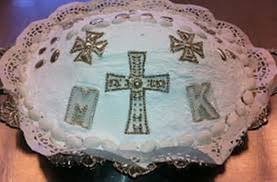MEMORIAL SERVICE

MEMORIAL SERVICES - also referred to as "prayers for the departed" - are special prayer services offered for the benefit of the deceased. It is the tradition on the Church to say a Memorial Service the third day (in remembrance of the third-day Resurrection of our Saviour); the ninth day (that the soul of the departed be conjoined to the nine ranks of Angels); the fortieth day (from the exxample of the mourning in the Old Testament for the death of Moses for forty days by the Israelites and because of the Ascension of our Lord on the fortieth day) and on the annual anniversary of death (because this day is their birth-day into Life Everlasting). In addition to these times, the Memorial Service is always offered for all the departed on four SATURDAYS OF THE SOULS (the two Saturdays preceding Great Lent, the first Saturday of Great Lent and the Saturday before Pentecost). One of the major components of the memorial service is "intercession". Orthodox Christians believe in the power of intercessory prayer or praying for others. It is believed that since the Last Judgment will occur during the Second Coming of Christ, intercessory prayers may still have an impact. when a Memorial Service is offered, it is customary for the family of the deceased to bring to the Church a dish of boiled wheat shaped into a mound or cake, to resemble a grave. The boiled wheat is placed on a table in the center of the nave during the Service. The wheat, known as Kollyva is a symbol of the Resurrection. When speaking of the Ressurrection, our Lord said: "Unless the grain of wheat falls into the earth and dies, it remains alone, but if it dies it bears much fruit." (Jn 12:24)
LA COMMÉMORATION DES DÉFUNTS
LA COMMÉMORATION DES DÉFUNTS ou « prières pour les défunts » — est un office particulier à la mémoire de chacun de nos défunts aux dates importantes après leur repos qui sont les troisième, neuvième, quarantième jours, et le jour anniversaire. La commémoration en ces jours-là vient de la tradition apostolique, instituée pour les raisons suivantes : Au troisième jour (la Résurrection du troisième jour de notre Sauveur); au neuvième jour (pour que l’âme du défunt soit jugée digne d’être du nombre du chœur des saints, par les prières des neuf rangs des anges) et au quarantième jour (en référence au peuple juif qui s’est lamenté 40 jours après la mort de Moïse). En outre, la commémoration des défunts un an après leur repos, et chaque année suivante, nous rappelle que ce jour est en quelque sorte leur seconde naissance, pour la vie éternelle. La Sainte Église a institué de plus des jours particuliers, qu’on appelle « ancestraux », pour une commémoration universelle de tous ceux qui sont morts dans la vraie foi (les deux samedis précédant le Grand Carême, le premier samedi du Grand Carême et le samedi précédant la Pentecôte). Il est de coutume que la famille du défunt apporte à l’Église un plat de blé, connu sous le nom de colybe (aussi kolives ou kolivo). Symbole de la Résurrection, la colybe est faite de grains de blé qui représentent le corps du défunt. Elle est l’expression matérielle de la croyance orthodoxe dans l’immortalité et dans la Résurrection. Comme le grain de blé pour germer et donner du fruit doit d’abord être enterré et se décomposer, de même le corps humain doit d’abord être enterré et se décomposer pour ressusciter inaltéré (Jn 12, 24).